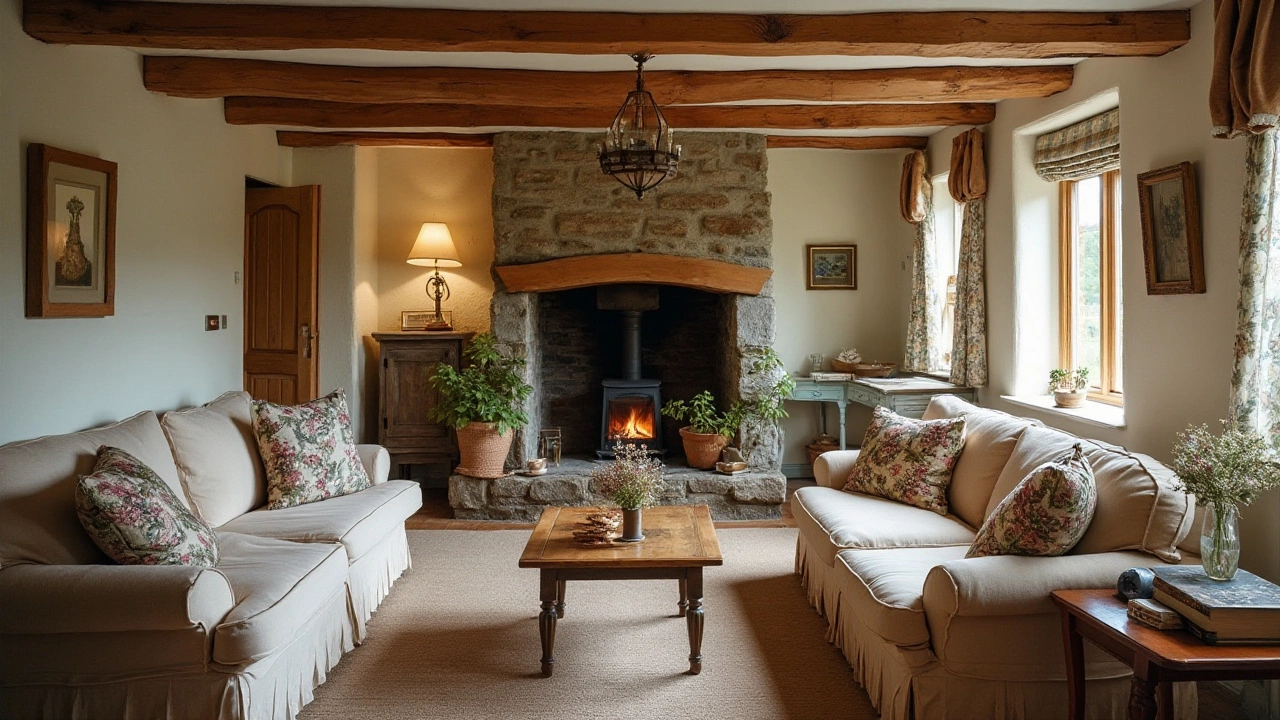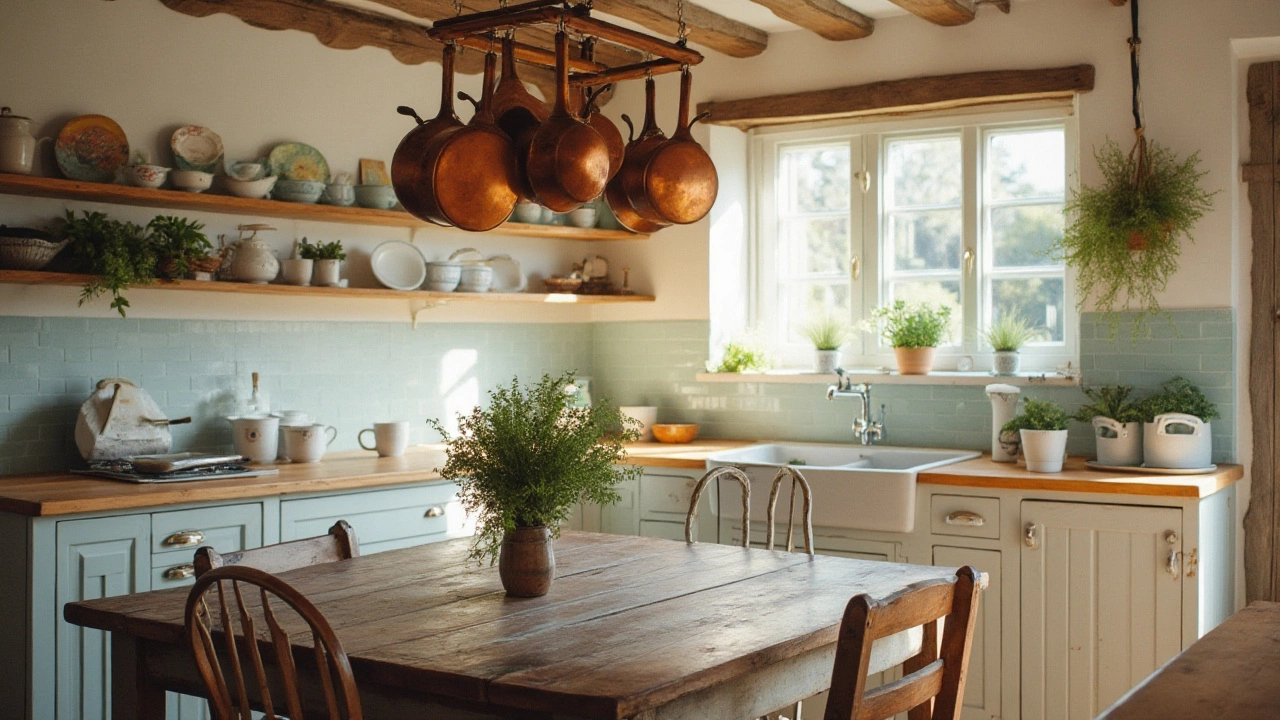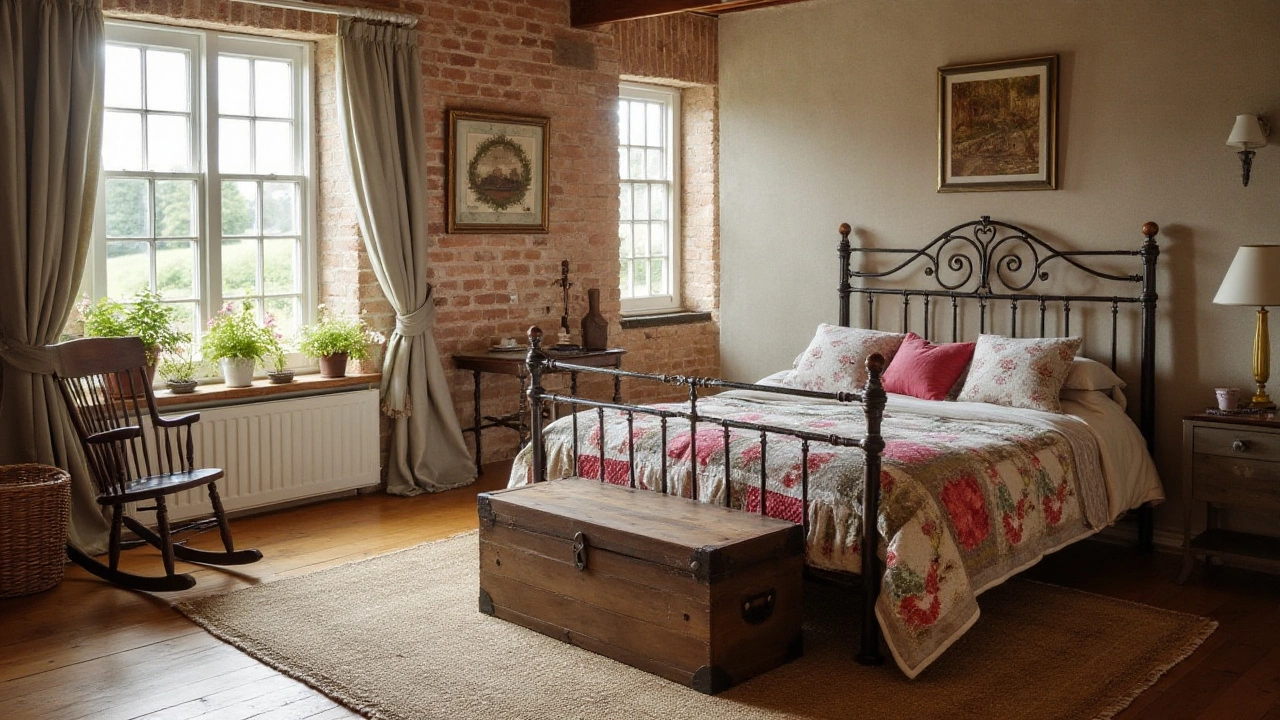Blending Farmhouse Chic with Cozy Cottage Style
 Oct, 11 2024
Oct, 11 2024
In home design, mixing styles can lead to magical outcomes, and this is certainly true when it comes to blending farmhouse and cottage aesthetics. These styles offer a unique pairing, with farmhouse design adding a rustic, utilitarian edge, while cottage decor brings a sense of softness and lived-in comfort.
Farmhouse interiors typically feature rough-hewn elements, paying homage to their agricultural roots, with materials like reclaimed wood, metal accents, and neutral color schemes. On the other hand, cottage design is all about embracing charm and relaxation, often characterized by pastel hues, floral patterns, and cozy textures.
When combined thoughtfully, the outcome can be a captivating mix of elegance and warmth. The aim is to strike a balance, using design elements that complement rather than compete. Think of combining a farmhouse's robust wooden dining table with the gentle touch of a cushioned cottage chair. It's about crafting a space that feels both grounded and inviting, perfect for any cozy home.
- Exploring Farmhouse Style
- Understanding Cottage Charm
- Harmonizing Elements from Both Styles
- Choosing Materials and Colors
- Curating Furniture and Accessories
Exploring Farmhouse Style
With its roots deeply embedded in rural charm and practicality, farmhouse style is a celebration of simple living and connection to the land. At its core, this design philosophy emphasizes functionality without sacrificing beauty, often blending seamlessly into various design categories. Homes designed in this style usually exhibit an unpretentious elegance that feels both timeless and welcoming, making it a favorite among those who want their abode to be more than just a place to live but an expression of tradition and hospitality.
One of the quintessential characteristics of farmhouse design is its use of natural and raw materials. Reclaimed wood, in particular, plays an essential role, being a staple for flooring, ceiling beams, and accents. This not only grounds the space with a sense of history but also adds warmth and texture that are hard to achieve with synthetic materials. Metal accents often appear in the form of light fixtures or kitchen hardware, adding a touch of industrial yet rustic flair.
Architectural Digest notes, "The charm of farmhouse style lies in its ability to marry the old with the new, creating a story that feels deeply personal."
Color plays a key role in defining farmhouse interiors. The palette typically revolves around neutral shades, predominantly whites, creams, and taupes, punctuated by wood tones and subtle hues like sage green or slate blue. These colors not only reinforce the airy and relaxed atmosphere that farmhouse style is known for but also serve as the perfect backdrop for other decorative elements like art and textiles. Textures, however, are anything but plain in farmhouse settings. Linen, cotton, and sometimes burlap feature prominently in soft furnishings, enhancing the tactile experience and comfort of the space.
A functional yet stunning addition to any farmhouse is the rustic kitchen. Here, practicality reigns but never at the cost of visual allure. Deep farmhouse sinks, or Belfast sinks as they are known, are often paired with butcher block countertops and shaker-style cabinetry. Open shelving is beneficial not just for ease of access but also for showcasing crockery, plants, and other charming kitchen paraphernalia. This open concept approach enhances the feeling of space and allows the rich character of the kitchen to shine through.
The enduring appeal of farmhouse style also sees it integrating well with modern sensibilities. Incorporating modern appliances or sleek decor pieces into a rustic setting can create a fusion that is both fresh and rooted. This style’s adaptability makes it versatile, appealing to those who yearn for a dash of nostalgia without forgoing contemporary conveniences. Whether in a bustling city apartment or a country home, farmhouse elements lend an aura of hospitality and charm, making any dwelling feel like a true retreat.
Understanding Cottage Charm
Cottage charm is a delightful design approach that celebrates intimacy, simplicity, and warmth. This style conjures images of cozy nooks, floral wallpapers, and a palette reminiscent of a gentle English garden. At its heart, the cottage aesthetic is about creating a lived-in environment that invites relaxation and cherishes the art of comfort. The color schemes often revolve around soft pastels, chalky whites, and earthy tones, fostering a soothing ambiance. These colors not only brighten spaces but also help to create the illusion of larger rooms, which is particularly beneficial in quaint cottages where space might be limited.
Furniture in cottage-style homes tends to be sturdy yet welcoming, featuring classic shapes and durable materials. You'll often find pieces that boast history, like a much-loved wooden rocking chair or an antique dresser, each telling its own story through the layers of patina. Fabrics used within cottages further enhance this feeling of comfort—think plush, overstuffed sofas adorned with hand-stitched quilts and pillows. Patterns are very much at home in this style, bringing balance through their gentle complexity. Floral, gingham, and even stripes can be mixed artfully, creating a pleasing visual rhythm.
Essential Elements of Cottage Decor
The charm of the cottage style doesn't stop at color and furniture—textures play an equally pivotal role. Natural materials like linen, cotton, and wool invite you to touch and interact, while worn finishes and weathered wood offer a rustic backbone. Such tactile elements are central to crafting spaces that feel authentic and lived-in. Personal touches are also fundamental, with a smattering of vintage treasures like old books, handcrafted pottery, and cherished family heirlooms adding character and soul.
Light is another crucial aspect that can define a cottage setting. Flood your spaces with natural light by using airy, light-colored curtains. The interplay of shadows and sunlight throughout the day can transform a room, adding a serene dynamic that artificial lights often struggle to replicate. Mirrors, too, cleverly placed, can amplify this effect, bouncing light and making spaces feel more expansive.
Cottage decor expert Sarah Moore once mentioned, "It's about creating a heartwarming retreat that mirrors the beauty of nature and the memories of a simpler time."
Achieving cottage charm isn’t about perfection but embracing imperfections. Homes with history and personality often wear these 'imperfections' as badges of honor. Don't be afraid to showcase cracked ceramics or paint-chipped chairs; these imperfections contribute to an authentic atmosphere. The cottage style, after all, is more than just a look; it’s an expression of a lifestyle that revels in warmth and nostalgia.
Staying true to what makes cottage style lovable, many choose to incorporate the elements found naturally in the surrounding environment. If you're lucky enough to live near a coastal region or a stretch of vibrant countryside, borrowing hues and materials can weave a seamless transition from the outdoors into your interior spaces. This thoughtful integration helps capture the essence of a picturesque country cottage, making every day feel like a retreat.

Harmonizing Elements from Both Styles
Blending farmhouse and cottage styles is akin to crafting a timeless melody, where each note plays its part to create harmony. Begin by identifying common themes, textures, and colors that link the two styles. Farmhouse interiors often boast rough-hewn finishes, neutral hues, and a sense of practicality born from their rustic origins, while cottage settings flourish with pastel palettes, floral patterns, and an enduring softness. Both have an emphasis on comfort and simplicity, reflecting a robust yet welcoming ethos. By combining the utilitarian charm of farmhouse with the quaint allure of cottage, you lay the groundwork for a space that feels both stylish and soothing, like a warm embrace at the end of a long day.
One effective way to harmonize these elements is through the clever use of materials and textures. Begin by selecting a farmhouse piece, such as a sturdy reclaimed wood table—a staple in this style. Surround it with upholstered chairs in soft, worn fabrics or a weathered finish to add that cottage touch. This mix not only balances the aesthetic but also elevates the room's functionality, making it more inviting and practical. Layers are your friend; layering different textiles like throws and cushions in various fabrics and patterns can effectively bridge the gap between both design philosophies. This approach helps to create visual interest, providing depth to what might otherwise be stark contrasts.
Color is another potent tool in achieving seamless integration. Where a farmhouse might lean towards a neutral base of whites, taupes, and greys, invigorate the base with cottage hues—think gentle blues or soft greens. These colors can appear subtly on walls, perhaps as an accent color or through decorative accessories, such as vases or wall art. Blend these into the farmhouse tendency of using substantial, impactful decor elements like metal lighting fixtures or rustic wooden beams. This balance retains the integrity of both styles, presenting a serene yet unifying atmosphere in your home.
Consider the words of renowned interior designer Joanna Gaines, who champions both styles in her work:
"Design is all about finding the balance between the old and the new, the structured and the relaxed, the rough and the refined."Her insightful approach underscores the importance of balance when merging these styles. Utilize this ethos by being intentional with your choices, ensuring there's a dialogue between different design elements, rather than a disjointed conversation. Let these expert perspectives guide your design journey, offering wisdom and clarity as you transform your home.
Another layer to consider is the use of personal touches to reflect the adaptability and warmth of both aesthetics. Decorate with personal mementos like framed family photos or beloved heirlooms, each carefully selected to echo the heartwarming appeal seen in traditional homes. These keepsakes, displayed in strategic spots, ensure the space is not just stylish, but also intimately yours. Take care to choose frames and display cases in finishes that tie back to the overarching color palette and style elements found in the room. This approach keeps the space uncluttered yet filled with character, embodying the seamless flow between farmhouse structure and cottage charm.
Choosing Materials and Colors
Blending farmhouse and cottage styles beautifully hinges on the careful selection of materials and colors, as these elements form the backbone of any design scheme. For a harmonious blend, consider starting with materials that resonate deeply with both styles. In the realm of farmhouse decor, think about the texture and warmth of wood, which is often untouched or reclaimed, maintaining visible knots and character. It tells a story that’s rich and authentic. You might envision a charming wooden beam cutting across a ceiling or wide plank wooden floors that capture the rustic spirit.
In terms of color, muted and neutral tones triumph in both cottage and farmhouse settings. Whites, creams, and soft greys lay a versatile groundwork, allowing more colorful elements to shine without overwhelming the space. But there's beauty in a dash of unexpected color. Consider soft pastels—like a dusk blue or gentle sage—that nod to the garden-inspired palette often found in cottage homes. These colors echo a sense of tranquility and calm, promoting a soothing atmosphere.
Another critical consideration is the integration of textures. Natural fibers such as cotton, linen, and wool add soft tactile elements often associated with cottage charm, infusing rooms with warmth and cosiness. Layering these materials, perhaps through throw pillows or woven blankets, adds dimension and comfort. An easy balance can be achieved by utilizing these fabrics to soften the more robust surfaces typical of farmhouse style, like wooden furniture and metal light fixtures. "Your home is living space, not storage space," author Francine Jay once wisely remarked, encouraging us to choose meaningful materials that speak to us personally.
Don't be afraid to introduce a mix of metals. While industrial and galvanized finishes in farmhouse styles might feel stark in isolation, when paired with the light hues or floral touches of cottage style, they transform into focal points that highlight both styles admirably. Opt for light fixtures, handles, and frames in matte black or brushed nickel to draw attention without clashing. These accents, both functional and decorative, help to anchor the design and add depth.
When you bring all these elements together, aim for balance rather than uniformity. Rather than a single style dominating the landscape, you want a genuine fusion that feels cohesive and naturally flows from one room to the next. By thoughtfully selecting materials and color schemes, you are crafting a narrative in your home that speaks of blended eras and sensibilities, making your living space truly unique.

Curating Furniture and Accessories
When it comes to merging farmhouse and cottage styles, thoughtfully selecting furniture and accessories becomes an art form. Each piece should resonate with the essence of both designs, offering balance and texture in the spaces they inhabit. Start with selecting substantial and timeless furniture pieces that speak to the farmhouse ethos, such as a sturdy wooden dining table or an oversized, comfortable sofa. These anchor pieces set the tone for the room and provide a canvas for injecting softer, cottage-style elements.
Embrace the idea of mixing materials. Farmhouse shines through distressed wood, wrought iron, and even galvanized metal, while cottage aesthetics love painted woods, wicker, and ceramics. Consider a dining room where a grand, aged wood table is paired with delicate vintage chairs, each coated in soft pastels or with floral cushions, bridging the gap between masculine and feminine energies harmoniously. Textiles are equally vital, so bring in a patchwork quilt draped over a leather couch or linen curtains beside a metal-framed window to achieve a perfect blend.
Accessories offer a chance to play with this dynamic more freely. Collections of pottery, both polished and rustic, can sit cozily on shelves, while vases filled with wildflowers brighten a tabletop and whisper cottage tranquility. Layering is where magic happens. An old ladder can hold woolen throws, elevating function to artistry. Books stacked alongside a pottery lamp can tell a story of travels and tales, perfect for living spaces or nooks dedicated to reflection and coziness.
"The key to successful mixing of styles is contrast that complements rather than competes," says renowned interior designer Julia Green. "Think yin and yang for your home, where different styles maintain their identity but also work together to produce something quite beautiful."
This delicate balance is not just about the big picture but also in the details. Add elements that capture your personal history—a carved picture frame, a woven basket. An honest blend of functionality and storytelling nurtures spaces that feel authentically yours. Incorporate home decor accessories like framed botanical prints or patterned rugs in connecting spaces like hallways or mudrooms to guide the eye and create a seamless transition from farmhouse formality to cottage charm throughout your home. Embrace layers, textures, and patterns; keep the heart of your home inviting and warm.